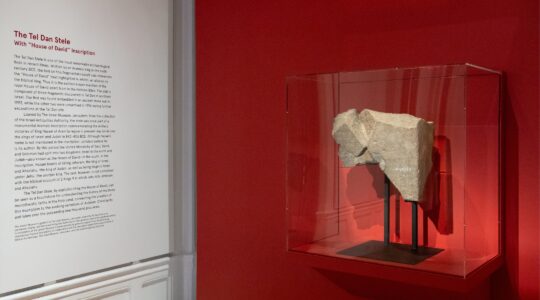WASHINGTON (JTA) — Peace in a year? Try getting past Sept. 26. Or is it 30?
Direct talks between Palestinians and Israelis have barely begun and already the sides are facing their first major hurdle — the end of Israel’s partial moratorium on settlement building.
Several issues might beset the sides as they aim to meet the yearlong deadline suggested by Israeli Prime Minister Benjamin Netanyahu and endorsed (with considerable enthusiasm) by President Obama and (with less enthusiasm) by Palestinian Authority President Mahmoud Abbas.
The hard questions — the status of Palestinian refugees and the sharing of Jerusalem — promise to vex the negotiators, as they have for years. Even before that point, however, a number of issues already are creating anxieties among negotiators in Jerusalem, Ramallah and Washington.
That moratorium:
Netanyahu placed a partial moratorium on settlement building to entice Abbas to the negotiating table. It lapses Sept. 26 — although not effectively until Sept. 30 because of the Sukkot holiday — and Netanyahu has said he will not renew it. Abbas says he will not be able to continue talks without it.
U.S. officials are pressing the sides to come up with a way out before the next meeting of the leaders, on Sept. 14 in Egypt. Michael Oren, the Israeli ambassador to Washington, has spoken of "incentivizing" the Palestinians with other gestures.
Oren did not elaborate, but Netanyahu has made a point of talking up economic incentives for the Palestinians, including increased commerce by reducing regulations and pulling away roadblocks.
Another way out would be for both sides to avoid questions about the deadline as it approaches and for the moratorium to continue, unofficially, without comment from either the Israelis or Palestinians. Most Israelis living within Israel’s pre-1967 borders — the area known as the Green Line — wouldn’t notice whether or not building was continuing in settlements, but the impact would be immediately noticeable to Palestinians.
Supporters of the settlement movement, however, say the current restrictions create burdens for the 300,000 Israeli Jews living in the West Bank. The settler community has vowed to protest unless settlement building returns to 2008 levels.
That deadline:
Netanyahu wants an agreement within a year, and before that an interim agreement outlining the parameters of a final status deal. He has made clear, however, in private conversations with U.S. officials that the agreement will be on paper until the Israeli leader is sure that he can secure his country’s borders — in other words, Israelis are saying nothing goes into effect for five, perhaps 10 years.
The Israeli expectation is that Abbas will be able to sell the Palestinian public a peace deal based on clearly detailed outlines of what they will get down the line — sort of like showing Junior the catalogue photo of the BB rifle he’ll get for his 15th birthday when he’s 10.
Abbas wants more tangible results, and his prime minister, Salam Fayyad, has suggested that a state could be in place by 2011. Fayyad later qualified this to say that he was referring to the infrastructure of a state, much the way that the Zionist movement had the instruments of statehood ready to go for years before Israel’s founding in 1948.
Abbas and the Palestinian Authority are seeking a patina of inevitability to fend off a challenge to their legitimacy by the Hamas terrorist group, which routed them from the Gaza Strip in 2007 and poses a challenge to them in the West Bank. What remains to be seen is whether state institutions — short of statehood — grants them that inevitability.
That border:
Netanyahu wants a demilitarized Palestinian state, which the Palestinians effectively conceded in the 1990s. But like his predecessors, he also wants a long-term, if not permanent, presence in the Jordan Valley, along the border with Jordan, to contain the threat from the east that for generations has exercised Israelis.
The Palestinians (and the Jordanians) counter, what threat from the east? The prospect of having to secure Israel’s longest border once may have been a concern, in terms of its drain on Israel’s military, but there is a peace treaty with Jordan and the United States has neutralized Iraq. And for the Palestinians, the point of the peace is to rid themselves of any continued notion of Israeli military occupation.
Iraq may be neutralized for now, the Israelis counter, but the region is inherently unstable and Iran is sinking its claims into Iraq.
That territory:
So within a year there is peace with the Palestinian Authority and mutual recognition, an end to all claims.
Well, except for Gaza, which is ruled by Hamas, which does not recognize Israel or any prospects for peace — and barely recognizes Abbas.
What does peace mean without the territory Israel referred to between 1949 and 1967 as a "dagger aimed at Tel Aviv" and the acquiescence of its 1.3 million Palestinians?
Just pretend and hope, Oren says.
"We are negotiating, we, the United States and the Palestinians are all three of us negotiating — throw the Egyptians and the Jordanians in there for good measure, too — as if the West Bank and Gaza are together when in fact we know they’re not," the envoy said recently. "The assumption is, if we cut a deal with the PA, and someday the people of Gaza throw off the Hamas yoke, they’ll join the peace arrangement."
That word:
Netanyahu has made clear he wants the Palestinians to recognize Israel as a Jewish state, and in this he has the Obama administration’s backing. The Israeli prime minister did not invent this formulation — Tzipi Livni introduced it in 2006 when she was foreign minister.
The rationale was that the PLO’s absolute recognition of Israel — extracted in excruciating negotiations by Netanyahu during his previous prime ministership, in 1998 — added up to not much. In the 2000 Camp David talks, the Palestinians insisted on a Palestinian right of return, which Israel believed added up to a peaceful plan for removing the Jewish state. The Palestinians also denied any Jewish claim to Jerusalem.
That was followed by the bloodshed of the second intifada, and for Israelis the failure to accept the Jews as a natural presence in the region became inextricably linked to the trauma of those years. The algebra was simple: Failure to recognize the Jewish claim equals anti-Jewish incitement equals violence.
Netanyahu has said that demilitarization and recognition of the Jewish claim are the keys to reaching a true peace deal.
The Palestinian Authority rejects this analysis. Its reasons for avoiding the Jewish claim is the responsibility that the Palestinian leadership feels for the 20 percent of Israelis who are Arab — it does not want to cut them out of their rights, although Netanyahu has said they will always be upheld.
There is also the sense among Palestinians that they have ceded enough by settling for "only" the West Bank and Gaza, 22 percent of British Mandate Palestine.
Nonetheless, there have been signs in recent months of movement here: In a meeting with U.S. Jewish leaders in June, Abbas recognized the ancient Jewish history in the area.
When Palestinian Diaspora intellectuals challenged this as capitulation last month, the PA mission in Washington pushed back not by parsing Abbas’ statement, but by repeating it and saying that it did not undermine the Palestinian claim.
JTA has documented Jewish history in real-time for over a century. Keep our journalism strong by joining us in supporting independent, award-winning reporting.





